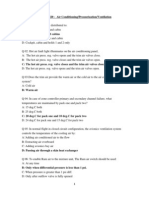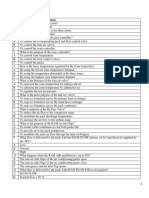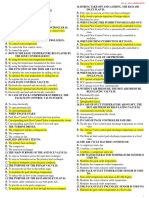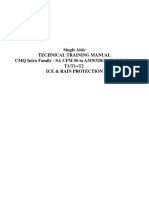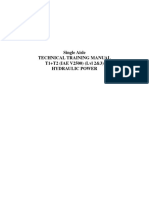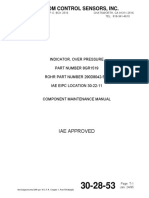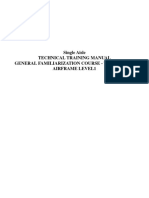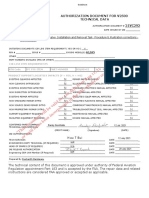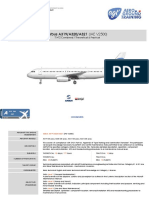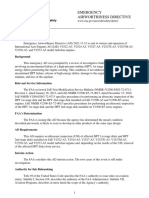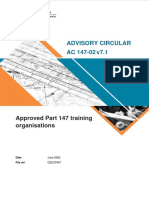Quiz IAE V2500 - Book - Aug12 (BGX)
Quiz IAE V2500 - Book - Aug12 (BGX)
Uploaded by
Nae GabrielCopyright:
Available Formats
Quiz IAE V2500 - Book - Aug12 (BGX)
Quiz IAE V2500 - Book - Aug12 (BGX)
Uploaded by
Nae GabrielOriginal Title
Copyright
Available Formats
Share this document
Did you find this document useful?
Is this content inappropriate?
Copyright:
Available Formats
Quiz IAE V2500 - Book - Aug12 (BGX)
Quiz IAE V2500 - Book - Aug12 (BGX)
Uploaded by
Nae GabrielCopyright:
Available Formats
Training Manual Study Questions
A319/A320/A321 IAE V2500
IAE V2500-Study Questions
71-00 General 7. Where are the drains located?
a) At the rear part of the pylon.
1. How is the thrust rating defined on the V2500-A1? b) At the bottom of the engine.
a) By an engine data programming plug. c) Both at the rear part of the pylon and at the bottom of the engine.
b) By a cockpit selection via MCDU.
c) Automatically by FADEC control. 8. Which fluids can be discharged through the drain?
a) Water, hydraulic, fuel and oil.
2. Which condition is sufficient to close the entry corridor? b) Water and fuel.
a) Engine running. c) Hydraulic and fuel.
b) Engine running above 80% of N2.
c) Engine running above minimum idle. 72-00 Modules
3. With the engine running, what is dangerous. 9. How is the main gearbox driven?
a) The inlet suction. a) By the HP rotor,
b) The inlet suction and the jet wake. b) By the LP rotor
c) The inlet suction, the jet wake and the noise. c) By the HP rotor via the angle gearbox.
4. An oil access door is provided for servicing: 10.The compressor stage Nº12 is:
a) On the right side fan cowl door. a) The 12th stage of the HP compressor,
b) On the left side fan cowl door. b) The 10th stage of the HP compressor,
c) On the left side thrust reverser "C" duct door. c) The 7th stage of the HP compressor.
5. A starter valve access panel is provided for manual operation: 11.What bearings support the HP rotor?
a) On the right side fan cowl door. a) Nº3 and Nº4,
b) On the left side fan cowl door. b) Nº3, Nº4 and Nº5,
c) On the left side thrust reverser "C" duct door. c) Nº2, Nº3 and Nº4.
6. The exhaust directs rearward:
a) The fan air discharge.
b) The engine core exhaust.
c) Both the engine core exhaust and the fan air discharge
Aug 12/Technical Training For training purposes only
Study Questions IAE V2500-1
Copyright by SR Technics
Training Manual Study Questions
A319/A320/A321 IAE V2500
73-00 Engine Fuel 18.With both engines running the Autothrust system is available?
a) Thrust levers between Idle and FLEX / MCT
12.What directly provides the closure of the PRSOV? b) Thrust levers between Idle and Climb
a) The FMU c) Thrust levers in any position
b) The EEC only 19.What power level is set if A/THR is lost
c) The MASTER lever to OFF position Answer:
13.Is same EEC channel always in command?
a) command altenates between channels on consecutive flight 20.In A/THR mode, will changes in the engine power cause movement of the
thrust lever?
b) both channels are in command
c) Always channel "A" in command and channel "B" can be selected by the Answer:
crew
14.What provides EEC with primary N2 signal? 21.HP fuel system is protected against excessive pressure by?
a) frequency of the dedicated single phase winding inside the PMA Answer:
b) dedicated sensor installed on the LP stub shaft
c) Hall effect sensor installed at the LP compressor case 22.How is icing / waxing of the fuel prevented at low temperatures
a) heat from the engine oil transferred from the FCOC
15.Which sensors are located at the diffuser case?
b) low voltage heating element around the fuel pipe
Answer: c) by the Fuel Return Valve (FRV)
23.How many torque motors are installed at the FMU and name them
16.What is the primary mode setting? Answer:
a) N1
b) EGT
c) EPR
17.How is the maximum power selected?
a) move the thrust levers to the FLEX / MCT detent
b) automatically by the Autothrust function on Ground only
c) move the thrust levers to the maximum travel stop TOGA
Aug 12/Technical Training For training purposes only
Study Questions IAE V2500-2
Copyright by SR Technics
Training Manual Study Questions
A319/A320/A321 IAE V2500
24.Servo fuel for the actuators is supplied from? 30. What causes an automatic continuous relight selection?
a) from the LP Pump a) IGN START selected.
b) directly from the fuel control unit b) Flame-out detected.
c) dedicated pipe taken away after the fuel flow transmitter c) EEC failure.
25.The overspeed and PRSOV are opened by? 31. What happens in manual mode when N2 reaches 43%?
a) electrically by actuators a) MAN START pushbutton ON light goes off.
b) pneumatically b) The EEC provides the ECAM with a message indicating that the start valve
c) metered fuel pressure must be closed.
c) The start valve automatically closes.
26.Fuel samples can be taken from?
Answer: 75-00 Airflow
1. What is the compressor airflow control system used for?
74-00 Ignition & Starting Answer:
27.When does the PRSOV open during manual engine start?
a) when the master lever is switched on and the metered fuel pressure over-
comes the closing spring on the PRSOV.
2. Which compressor valve is fully modulating?
b) as soon as the master lever switch is switches to the on position
c) simultaniously with the LP fuel valve Answer:
28. How does the starter operate?
a) Electrically. 3. Do the IGV and the VSV have a seperate actuator?
b) Pneumatically. Answer:
c) Hydraulically.
29.In which case can the EEC abort the start? 4. IGV and VSV are fitted at which stages of the HP compressor on A1 and A5?
a) Automatic start and manual start. Answer:
b) Automatic start only.
c) Wet motoring.
d)
Aug 12/Technical Training For training purposes only
Study Questions IAE V2500-3
Copyright by SR Technics
Training Manual Study Questions
A319/A320/A321 IAE V2500
5. Where is the servo pressure for stage 7 and 10 handling bleed valve taken a) stage 10 air
from? b) stage 12 air
a) 10th stage c) fan air
b) P3 12.Make-up air valve is closed at which conditions? (pre-mod engine)
c) P2.5
Answer:
6. Which handling bleed valve open, should a compressor surge occur
Answer:
7. What is the fail safe position of a handling bleed valve, should the electrical
control solenoid fail?
Answer:
8. Is the fuel diverter valve a modulating valve?
Answer:
9. Is the fuel return to tank flow valve modulating?
Answer:
10.What flight condition inhibit the fuel return to tank flow?
Answer:
11.Air is supplied to the active clearance control (ACC) system by?
Aug 12/Technical Training For training purposes only
Study Questions IAE V2500-4
Copyright by SR Technics
Training Manual Study Questions
A319/A320/A321 IAE V2500
13.Stage 10 HPC make-up air provides? 2. Which engine parameters are diplayed on the E/WD?
a) extra cooling air for stage 2 HPT and blades Answer:
b) servo pressure for handling bleed solenoid valves
c) cooling of bearing no.4 compartment only
14.What air is used for cooling the HPC 12 air in the ACAC
Answer: 3. Which engine parameters are diplayed on engine system display?
Answer:
15.What is the cooled HP 12 air used for?
Answer:
4. Which speed signal is supplied to the EVMU?
a) N1 only
b) N1 and N2
16.What is the fail safe position of the engine anti-ice valve?
c) N2 only
a) closed
b) last commanded position 5. How many probes interact with the phonic wheel?
c) open
Answer:
17.When and how is the P2/T2 probe heated?
Answer:
6. How many thermocouples measure the EGT
a) one
b) three
77-00 Indication
c) four
1. N1 speed signal is sensed from?
7. EGT is measured at which engine station?
a) a dedicated wiring inside the PMA
b) speed probes interacting a phonic wheel in the front bearing compartment Answer:
c) speed probes sensing the rpm of the HP turbine shaft
Aug 12/Technical Training For training purposes only
Study Questions IAE V2500-5
Copyright by SR Technics
Training Manual Study Questions
A319/A320/A321 IAE V2500
8. Where is the P2/T2 probe located? 14.What senses the movement of the translating cowls
Answer: Answer:
9. Which shaft does the air starter rotate 15.How is the movement of the translating cowls synchronised?
a) By the Engine Control Computer (EEC)
Answer: b) By a flexible drive cable between the actuators
c) The two halfs are not synchronized to each other
10. How is the selection of the accelerometer sensors performed? 16.What is the logic of the reverse operation?
a) The EEC selects the sensor to be used. a) TLA position and aircraft on ground only.
b) The EVMU selects automatically a sensor for each flight. b) TLA position, aircraft on ground and Reverse indication green.
c) The MCDU is used to select the sensor to be used for the next flight. c) TLA position, aircraft on ground, engine running (N2 condition) and both
SECs and EIU signals.
78-00 Exhaust 17.What does the CFDIU simulate during the MCDU reverse test?
a) The TLA.
11.Where is the Hydraulic Isolation Valve located?
b) The ground logic.
a) Inside the Hydraulic Control Unit (HCU) c) The N2 condition.
b) Inside the Spoiler Elevator Computer (SEC)
18.What is the purpose of the auto-restow system?
c) in the Hydraulic “Tee” connection
a) To restow the thrust reverser immediately after detection of any uncom-
12.When is it possible to operate the thrust reverser system? manded movement.
b) To restow the thrust reverser after detection of any uncommanded move-
a) On ground only, ment of at least 10% of travel.
b) On ground and in flight, c) To automatically restow the thrust reverser on cancellation of a deploy com-
c) In flight only. mand.
13.In flight what position and power state is the DCV (Directional Control Valve)?
Answer:
Aug 12/Technical Training For training purposes only
Study Questions IAE V2500-6
Copyright by SR Technics
Training Manual Study Questions
A319/A320/A321 IAE V2500
19.Which important safety procedure should be performed prior any maintenance 6. What is the pupose of the No.4 bearing scavenge valve?
work on or under the c-duct?
Answer:
Answer:
7. Name the two temp sensors in the oil system
79-00 Engine Oil Answer:
1. How is the oil system protected from high pump delivery pressure?
Answer:
8. The ECAM oil pressure indication is?
2. Has the pressure filter a bypass valve fitted? a) Pressure pump delivery minus No.4 bearing scavenge pressure
Answer: b) Pressure pump delivery pressure
c) Scavenge pump pressure
3. Where does the filter clog message on the ECAM come from? 9. What happens if the oil scavenge filter is clogged?
a) Oil filter clog warning is activated in the cockpit.
Answer:
b) Visual clogging indicator on the filter becomes red.
c) Oil low press switch closes.
4. How is the main cooling of the oil system achieved?
10.Which of the following is not directly scavenged?
a) FCOC LP fuel system
a) 1, 2, 3, Bearing compartment.
b) ACOC
b) No 4 Bearing compartment.
c) IDG FCOC
c) No 5 Bearing compartment.
5. How is the oil removed from Bearing No.4 compartment?
a) by a scavenge pump located in the gearbox
b) by air pressure entering the compartment through the carbon seals
c) by suction generated of the de-oiler
Aug 12/Technical Training For training purposes only
Study Questions IAE V2500-7
Copyright by SR Technics
Training Manual Study Questions
A319/A320/A321 IAE V2500
Aug 12/Technical Training For training purposes only
Study Questions IAE V2500-8
Copyright by SR Technics
You might also like
- My Cracked Addons For X-Plane 12Document17 pagesMy Cracked Addons For X-Plane 12snakkers0150% (2)
- A320 321 PW1100G - Question Bank5412481902795341096Document12 pagesA320 321 PW1100G - Question Bank5412481902795341096Trần Việt Cường100% (4)
- A320 Systems Exam AnswersDocument14 pagesA320 Systems Exam Answersakifilou100% (23)
- Caav Question Bank - A320321Document88 pagesCaav Question Bank - A320321Tung Phungvan88% (17)
- Airbus A320 Question BankDocument147 pagesAirbus A320 Question BankSunny Ayekpam100% (4)
- A320 ExamDocument79 pagesA320 ExamKhaled Elmabrouk93% (27)
- A319/A320/A321 Technical Training Manual T1+T2 Mechanical and Avionics A319/A320/A321 IAE V2500 General A/C Systems (Level1)Document112 pagesA319/A320/A321 Technical Training Manual T1+T2 Mechanical and Avionics A319/A320/A321 IAE V2500 General A/C Systems (Level1)Prajwal Patidar100% (1)
- Dgca Airbus A320 Question BankDocument148 pagesDgca Airbus A320 Question BankAtharav Ansil Chowdhary100% (3)
- Final Quiz VACBI (A320)Document36 pagesFinal Quiz VACBI (A320)Khurram Naseem100% (3)
- Dgca Airbus A320 Question BankDocument133 pagesDgca Airbus A320 Question BankSunny Ayekpam88% (8)
- A320 Tech QuestionsDocument201 pagesA320 Tech QuestionsAyan Acharya90% (10)
- A320 QBDocument88 pagesA320 QBraiday8469% (16)
- Cfm56 TestDocument6 pagesCfm56 Testccoyure100% (2)
- A320 System QuestionsDocument168 pagesA320 System QuestionsEmre ÖzalNo ratings yet
- V2500Document15 pagesV2500Anastasios Pavlou100% (1)
- Chapter 70 A320 QuestionsDocument3 pagesChapter 70 A320 Questionsanon_733892826No ratings yet
- A320/321 (PW1100G) - Question Bank: Page 1 of 12Document12 pagesA320/321 (PW1100G) - Question Bank: Page 1 of 12Phạm Hà TiếnNo ratings yet
- Owner'S & Operator'S Guide: V2500Document22 pagesOwner'S & Operator'S Guide: V2500Robertas NegudinasNo ratings yet
- A320 EngineDocument4 pagesA320 Enginemorteeza1986100% (3)
- A320 70 cfm56Document18 pagesA320 70 cfm56morteeza1986100% (3)
- A320 QuestionsDocument66 pagesA320 QuestionspravinNo ratings yet
- Caav Question Bank - A320/321: A. B. C. DDocument87 pagesCaav Question Bank - A320/321: A. B. C. DJivendra KumarNo ratings yet
- CFM56-5A-5B CO-063 Basic Engine Feb2014Document27 pagesCFM56-5A-5B CO-063 Basic Engine Feb2014Kelik Arif100% (2)
- A320 Question AnswerDocument51 pagesA320 Question AnswerJivendra KumarNo ratings yet
- V2500 TSDocument18 pagesV2500 TSalex100% (3)
- A320 Questionnaire1Document142 pagesA320 Questionnaire1alegiustizieri77% (22)
- Hydraulic System A320 QuestionsDocument10 pagesHydraulic System A320 Questionsricardo4navarro-4100% (2)
- (Vjc-A320) Question PDFDocument74 pages(Vjc-A320) Question PDFmiew100% (7)
- PPL Exam Secrets Guide - Aircraft General & Principles of FlightFrom EverandPPL Exam Secrets Guide - Aircraft General & Principles of FlightRating: 5 out of 5 stars5/5 (2)
- V2500 Line and Base Maintenance Engine OverviewDocument24 pagesV2500 Line and Base Maintenance Engine OverviewHENIGUEDRI100% (2)
- A320 49, 70-80 - 1 (With Answers)Document7 pagesA320 49, 70-80 - 1 (With Answers)bayu axselan nugrahaNo ratings yet
- QB A320 FA NEO DifferencesDocument10 pagesQB A320 FA NEO DifferencesPhạm Hà Tiến33% (3)
- A320 Mock ExamDocument15 pagesA320 Mock ExamAkhil Sharma100% (1)
- A320 1 Neo Hat 5517097601510181251Document27 pagesA320 1 Neo Hat 5517097601510181251Trần Việt CườngNo ratings yet
- A330 Important PointsDocument4 pagesA330 Important PointsArindam Dutta100% (2)
- Ata 71-80: Power PlantDocument20 pagesAta 71-80: Power PlantTrần Việt Cường100% (2)
- Iae V2500 Engine Questions: TH THDocument12 pagesIae V2500 Engine Questions: TH THRafael Santos100% (1)
- CFM 56Document21 pagesCFM 56Anastasios Pavlou100% (1)
- Quiz CFM1Document3 pagesQuiz CFM1ccoyure100% (1)
- CFM56 ElpoDocument8 pagesCFM56 Elpoelbouaishimoftah100% (1)
- Multiple Choice QuestionnaireDocument26 pagesMultiple Choice QuestionnaireTrần Việt Cường100% (1)
- Cau Hoi On Tap - A320&A321 For Category ADocument17 pagesCau Hoi On Tap - A320&A321 For Category ATung Phungvan100% (1)
- A320 EXAM 5 Q & POINTS - NoRestrictionDocument31 pagesA320 EXAM 5 Q & POINTS - NoRestrictionHENIGUEDRINo ratings yet
- A320 Neo Leap 1a Ata - 28Document43 pagesA320 Neo Leap 1a Ata - 28basid911No ratings yet
- Vragen VACBI A330-200 ATA 29Document3 pagesVragen VACBI A330-200 ATA 29Arkadiy Chernov100% (1)
- Tips A320 ResetDocument82 pagesTips A320 Resetgarry pangkey100% (1)
- A320 Aircraft General McqsDocument3 pagesA320 Aircraft General McqsZain HasanNo ratings yet
- Level A QBDocument27 pagesLevel A QBraiday84No ratings yet
- A320 To A321 DifferencesDocument13 pagesA320 To A321 DifferencesNancy Jeannette100% (1)
- Vragen VACBI A330-200Document7 pagesVragen VACBI A330-200Arkadiy Chernov100% (1)
- 29-03-2023 08 41 29 - ATA 7x A321 NEODocument4 pages29-03-2023 08 41 29 - ATA 7x A321 NEOPhạm Hà Tiến100% (2)
- A320PW11G-B12-0007.1, 70-72 PP Gen, R1 010217Document136 pagesA320PW11G-B12-0007.1, 70-72 PP Gen, R1 010217Marwa Mandeel100% (2)
- Pw1100G Hightest Thrust Be Set Up To7097871797088428933Document13 pagesPw1100G Hightest Thrust Be Set Up To7097871797088428933Phạm Hà Tiến100% (5)
- Red Book AnswersDocument19 pagesRed Book Answersgemechuteshale63No ratings yet
- Home Work Ata 71Document5 pagesHome Work Ata 71nejib benamorNo ratings yet
- NAA OPC 3 Questionnaire Rev 0Document5 pagesNAA OPC 3 Questionnaire Rev 0Sergio VolpiNo ratings yet
- Abinitio 2017 SET B 31st Mar'17Document9 pagesAbinitio 2017 SET B 31st Mar'17Aditya KumarNo ratings yet
- Home Work Ata 00Document14 pagesHome Work Ata 00nejib benamorNo ratings yet
- Extended Refresher (Gap in Flying) CPL-LOI pilots Course No 3Document4 pagesExtended Refresher (Gap in Flying) CPL-LOI pilots Course No 3Daksh ChhabraNo ratings yet
- HOME WORK PHASE 1-cDocument15 pagesHOME WORK PHASE 1-cnejib benamorNo ratings yet
- Abinitio 2017 SET 1 - 30th Mar'17Document10 pagesAbinitio 2017 SET 1 - 30th Mar'17Aditya KumarNo ratings yet
- Q 400 SYSTEM BestDocument9 pagesQ 400 SYSTEM BestTeddy EshteNo ratings yet
- Final Systems Test 2Document17 pagesFinal Systems Test 2sayeed1093No ratings yet
- Atr 72-600 QB 382QDocument71 pagesAtr 72-600 QB 382QMohamed WazilNo ratings yet
- V2500 General Familiarization: For Training Purposes Only Pratt & Whitney Proprietary InformationDocument314 pagesV2500 General Familiarization: For Training Purposes Only Pratt & Whitney Proprietary InformationVu Nguyen TuanNo ratings yet
- Approved CAR 147 Maintenance Training Organization (Capability List)Document3 pagesApproved CAR 147 Maintenance Training Organization (Capability List)Abhishek Kumar SinghNo ratings yet
- A 320 NEO Diff CEO SystemsDocument115 pagesA 320 NEO Diff CEO SystemsLeonardo Rizzi100% (9)
- 21 AIR CONDITIONING RDocument84 pages21 AIR CONDITIONING Rescobaragustin161No ratings yet
- Aac5 2001R2Document77 pagesAac5 2001R2ShivamSrivastavaNo ratings yet
- FSX Fslabs A320 GuideDocument124 pagesFSX Fslabs A320 GuideChurchill06No ratings yet
- 30 Ice & Rain ProtectionDocument8 pages30 Ice & Rain ProtectionYosri BoussennaNo ratings yet
- 29 Hydraulic PowerDocument114 pages29 Hydraulic PowerVitty PhanNo ratings yet
- Single Aisle Technical Training Manual T1+T2 (IAE V2500) (LVL 2&3) APUDocument250 pagesSingle Aisle Technical Training Manual T1+T2 (IAE V2500) (LVL 2&3) APU이용일No ratings yet
- Custom Control Sensors, Inc.: Iae ApprovedDocument6 pagesCustom Control Sensors, Inc.: Iae ApprovedjordiNo ratings yet
- Single Aisle Technical Training Manual General Familiarization Course - T4 (Iae V2500) Airframe Level1Document210 pagesSingle Aisle Technical Training Manual General Familiarization Course - T4 (Iae V2500) Airframe Level1chintanNo ratings yet
- Single Aisle Technical Training Manual T1 (IAE V2500) (LVL 2&3) PneumaticDocument50 pagesSingle Aisle Technical Training Manual T1 (IAE V2500) (LVL 2&3) PneumaticAnh NguyenXuanNo ratings yet
- Ata 71 A 80 Power Plant Iaev 2500Document310 pagesAta 71 A 80 Power Plant Iaev 2500juanNo ratings yet
- Emc 3 TTM Level 1 PPDocument224 pagesEmc 3 TTM Level 1 PPPrajwal PatidarNo ratings yet
- 29 Hydraulic PowerDocument86 pages29 Hydraulic PowerDarkmaster JNo ratings yet
- Annex To Decision ED 2019-024-RDocument128 pagesAnnex To Decision ED 2019-024-RSandy KurniawanNo ratings yet
- General Level 1Document74 pagesGeneral Level 1ANDRESXOXNo ratings yet
- This Document Will Be Valid For 180 Days From Aug 11, 21 or Until It Has Been Incorporated in The EM, Whichever Occurs First.Document9 pagesThis Document Will Be Valid For 180 Days From Aug 11, 21 or Until It Has Been Incorporated in The EM, Whichever Occurs First.Pradeep K sNo ratings yet
- AMO Listing 06092021Document34 pagesAMO Listing 06092021rameshneupaneNo ratings yet
- SATC-TF-23 - IAE V2500 ENGINE Practical Element Training BookletDocument21 pagesSATC-TF-23 - IAE V2500 ENGINE Practical Element Training BookletAamir JavaidNo ratings yet
- Training Syllabus Airbus 320 IAE V2500Document4 pagesTraining Syllabus Airbus 320 IAE V2500Arturo GuevaraNo ratings yet
- A320 Act Trainer by Airbus Installation GuideDocument30 pagesA320 Act Trainer by Airbus Installation GuideThinhj NguyeenxNo ratings yet
- Emergency Airworthiness Directive: FAA Aviation SafetyDocument4 pagesEmergency Airworthiness Directive: FAA Aviation SafetyBahadorNo ratings yet
- AC 147-02 v7.1Document116 pagesAC 147-02 v7.1Dalia MuraddNo ratings yet
- A320fam Ata22 Auto FlightDocument229 pagesA320fam Ata22 Auto FlightSourab MukherjeeNo ratings yet
- MCC Engineer & Aircraft Maintenance Engineer B1 CV Ahsan MujeebDocument4 pagesMCC Engineer & Aircraft Maintenance Engineer B1 CV Ahsan MujeebahsanmujeebNo ratings yet





